Finland have qualified for their first major tournament since the Sweden 2013 Euro finals. The 28th-ranked team in the world have a desire to reach another semi or quarter-final after failing to reach the knockout rounds of this competition since the 2009 edition.
Finland do not have lots of experience in major international tournaments, having never qualified for the World Cup and failing to qualify for the last Euro finals in 2017. The team will need to work together and not look for any individual brilliance to stand any chance of beating the other teams in the group.
However, Finland are not expected to progress in the tournament with the extremely high strength of the others in their group, the expectation is that they won’t get out of the group. Germany and Spain are ranked fourth and seventh in the world, respectively, and are two of the favourites for the Euros with both teams regularly competing for major tournament wins. Along with these two powerhouses, 15th-ranked Denmark will also be looking for a deep run in the competition with a young and exciting squad at their disposal.
This article will be a tactical analysis preview of Finland ahead of the Euros this summer in the form of a team scout report. It will be an analysis of Anna Signeul’s tactics to predict how Finland will set up in the upcoming tournament.
Predicted Starting XI
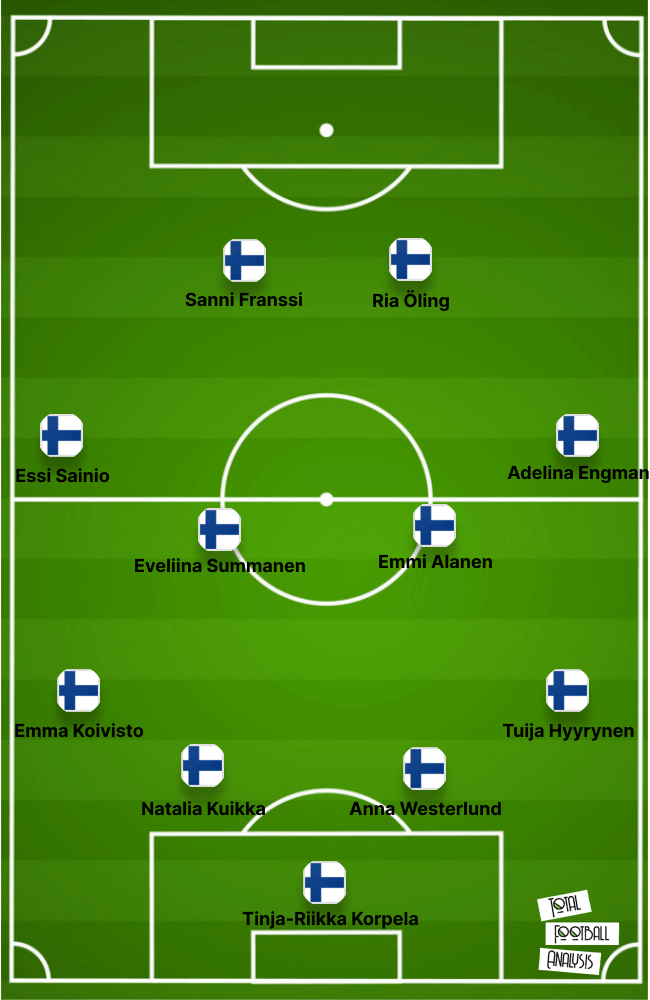
Finland have used a 4-4-2 formation in all of their World Cup qualifiers before this tournament, except for their most recent match against Georgia in which they changed the formation to a 3-4-1-2, while also using a highly changed starting XI for the contest.
Anna Signeul’s team are comfortable and familiar with the 4-4-2 formation, making the system fluid and highly effective for working as a team and less as individuals. The high intensity of the team will force Finland to change players during the tournament or to make substitutions more frequently than the other teams in the group. Anna Signeul also has a starting XI that she is confident in, with the players rarely being changed within the system.
One of the first names on the team sheet will be goalkeeper Tinja-Riika Korpela. The current first-team goalkeeper for Tottenham Hotspur and a two-time Bundesliga winner with Bayern Munich. Korpela has over 100 caps for the national team and is unlikely to not start, owing to her ability and experience in major tournaments. The two backup goalkeepers, Anna Tamminen and Katriina Talaslahti, do not have anywhere near the honours or experience of Korpela and will not be expecting to play during the tournament.
Finland’s defence is the strongest aspect of their squad with experience and trophies in every position along the backline. The full-backs for Finland both play at a high level with Tuija Hyyrynen a highly successful player starting for multiple-time winners of Serie A — Juventus — at the age of 34. The defender is Finland’s sixth-most capped player and will be looking to become the fourth-most capped player by the end of the tournament. Emma Koivisto, on the opposite side, starts for Brighton & Hove Albion in the WSL and will be looking to play in her first Euro tournament since playing in the WSL.
At centre-back, Finland also have lots of quality with Natalia Kuikka and Anna Westerlund forming the backbone of the Finnish national team. Westerlund has the record for the number of appearances for the Finland national team and will be hoping to have a great tournament as it may potentially be her last. Kuikka alongside her is a three-time winner of Finland’s Player of the Year award at the age of 26. She currently plays for NWSL side Portland Thorns and will be an important player for years to come with the national team.
Finland’s midfield does not boast the accolades of the defence but has lots of players who suit the style of the team, with the ability to play at a high intensity and cover lots of ground on the pitch. The position with the most rotation is the wide midfielders; in the starting XI Adelina Engman and Essi Sainio started the majority of matches in the World Cup qualifiers and are most likely to start in the Euro finals. Sainio is the oldest winger in the side with the ability to play at full-back, enabling Finland to change to the 3-4-1-2 seen in their most recent match. Engman is their ninth-highest goal scorer and poses a major attacking threat for the team. There is plenty of competition for places with Nora Heroum having played multiple seasons at the top leagues in Europe. She will be looking to get some game time under her belt as the squad is rotated during the tournament.
In the centre of the park, Emmi Alanen and Eveliina Summanen have been staples of the midfield and are solid players in those positions with the ability to play as box-to-box midfielders and hound the opposition for the duration of the match.
The forwards in the squad have lots of quality, with Sanni Franssi and Ria Öling most likely to start up front, but Linda Sällström will be keen to keep her spot in the starting XI as her national team’s all-time top goalscorer. It is very difficult to predict who will start most of the matches but there is no doubt in our eyes that Sällström is going to start at least one game at the tournament. However, at the age of 33, the younger players will be able to keep up the high intensity necessary in the demanding playstyle for most of the tournament.
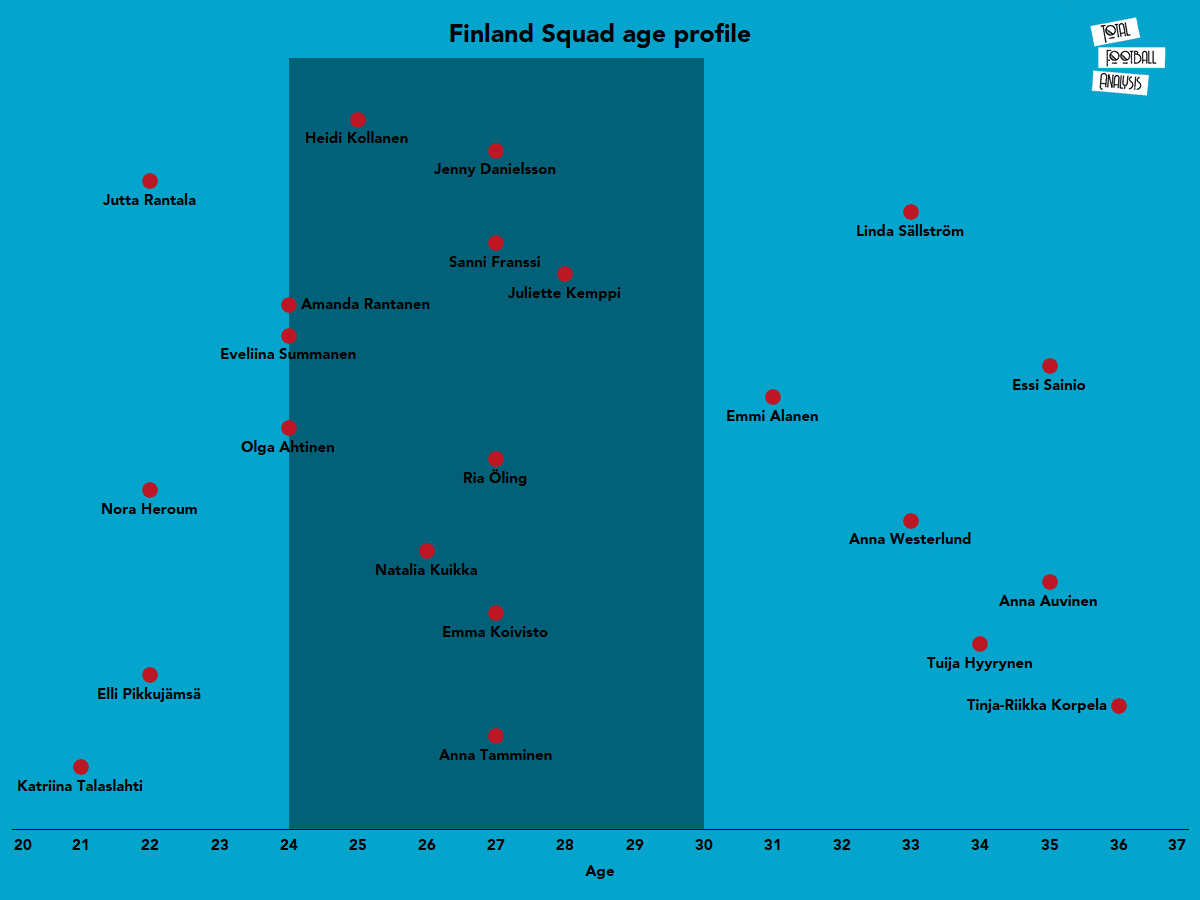
As seen from the graphic, the majority of Finland’s team have reached their peak (24 to 30) or are beyond their peak which could be a valuable mix to have if they get the balance between experience and athleticism right, on the pitch. Experience is important for major tournaments such as the Euro finals where many players will be lacking the understanding of what it takes to succeed at these events.
The squad has a core of these more experienced players with Westerlund, Hyyrynen, Korpela, Sällström, and Sainio all having played for many years at the national level, and this experience will be required to guide this squad and give them the best chance of getting out of the group stage. Undoubtedly, the players at their peak are fundamental to the system Finland plays to maintain the high press.
Most likely, the players under their peak will not get game time, but the experience from these tournaments will be important for the future of the team.
Attacking Phase
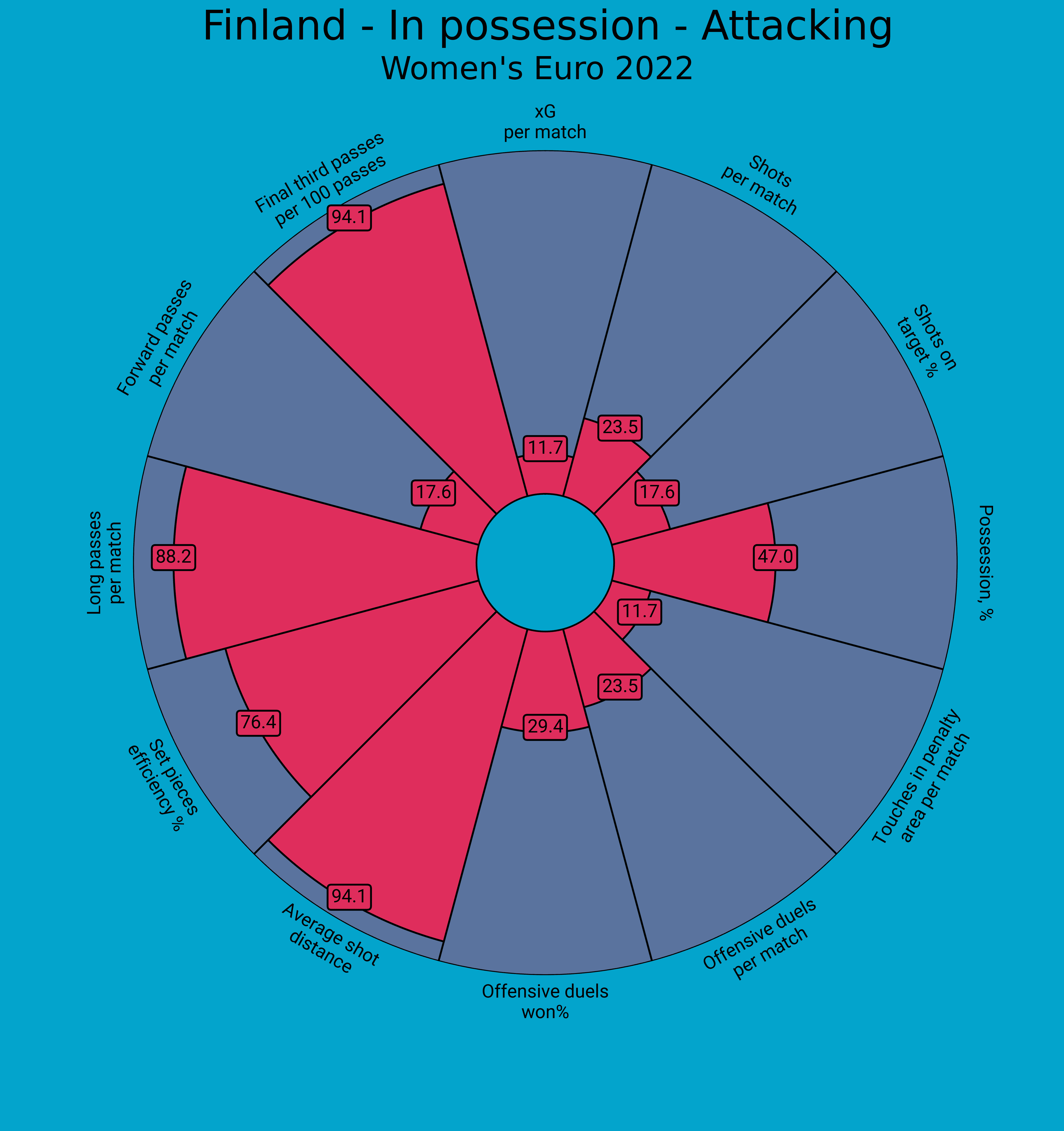
Finland don’t have a tonne of variety in their game plan and their attacking strategies, regardless of whether they’re up against stronger or weaker opponents, don’t really change. Due to the high number of games played in this system, their playing style has become an intuitive part of the players’ movement when in possession of the ball, often with perfectly timed runs onto passes in behind the opposition. This is clear from the graphic, showing their high frequency of passes into the final third.
The play often starts with the ball circulating around the defence with the ultimate aim of getting the full-backs on the ball. The full-backs will be on the touchline trying to utilise the full width of the pitch. This provides the central midfielders and central defenders with lots of space to move into to get on the ball or use the time to pick out a pass. The central midfielders are not frequently used to progress the ball but will look to switch the play and create passing options to move the ball on from the centre-back to the full-back.
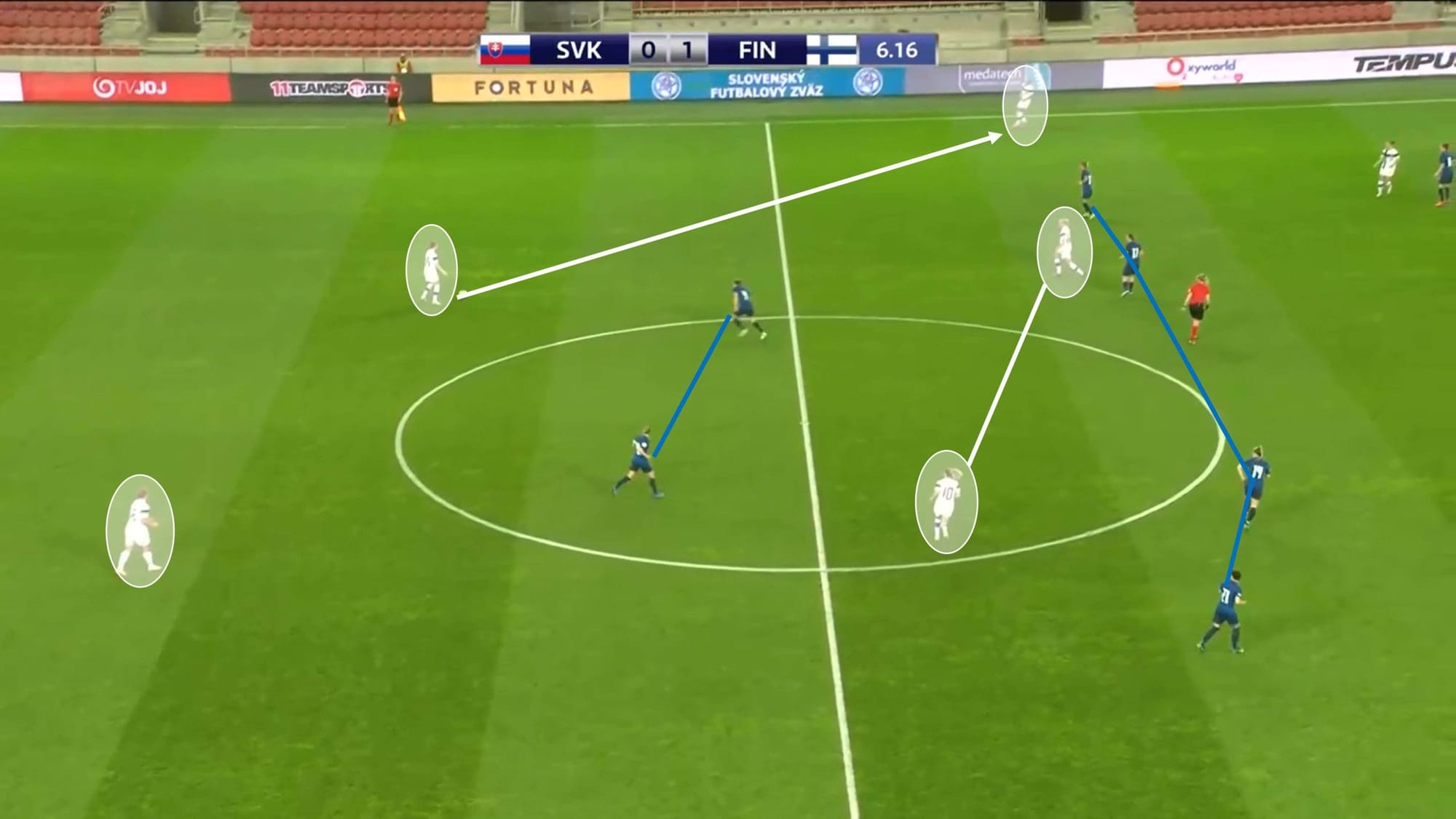
Finland aims to get the ball down the wide channel and in behind the opposition defence. These passes can come from the full-back or the centre-backs with a long ball that always goes to the same area of the pitch.
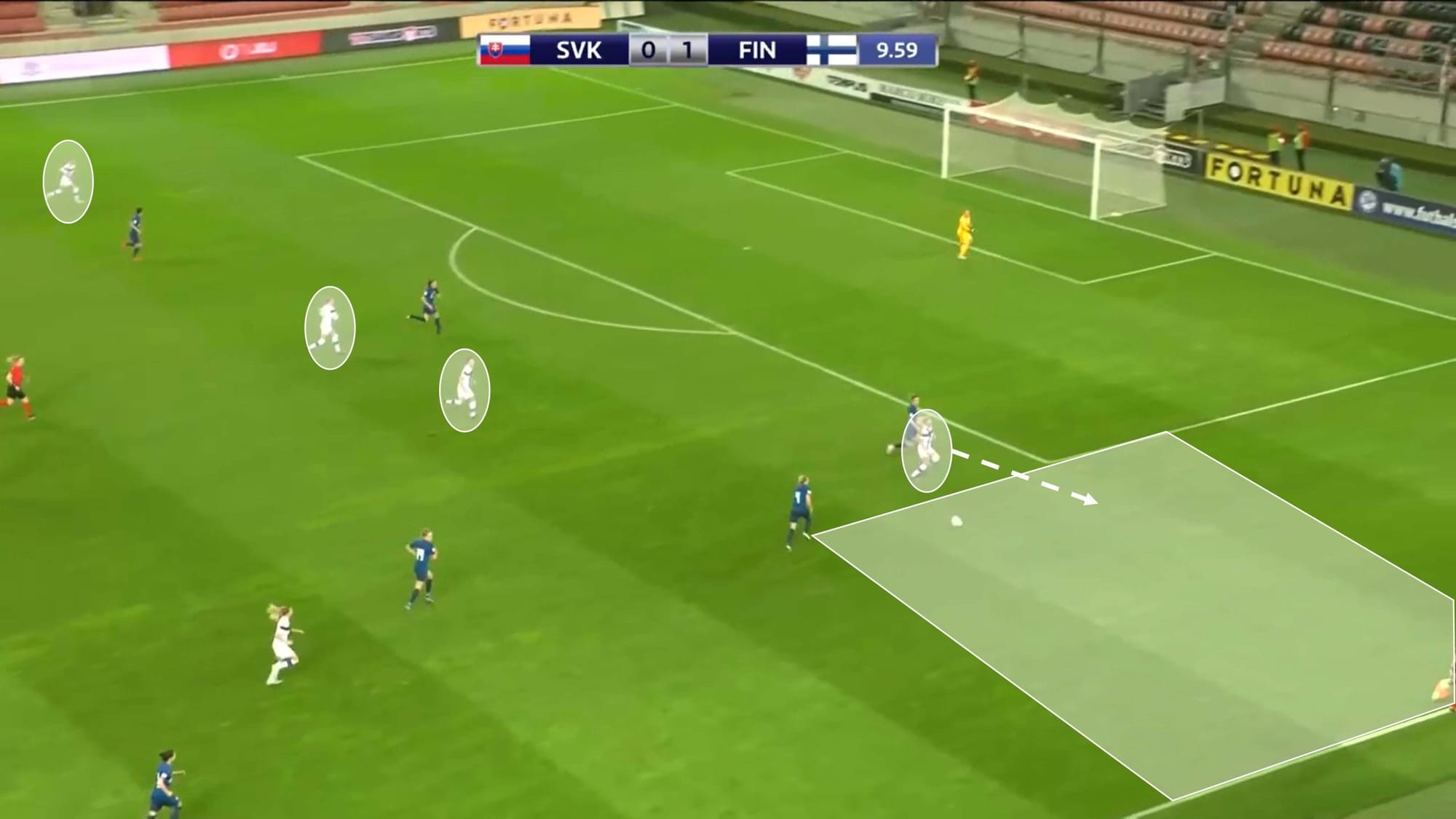
These long passes into the wide channels are received by the strikers or wide midfielders as the strikers look to work off each other in behind. Both strikers will look to go in behind and will very rarely show for the ball to feet.
From the wide channel, Finland look for crosses into the box, as lots of bodies flood forward often picking out a late run from a central midfielder onto the edge of the box.
This playstyle is very demanding, requiring high fitness to continually go from box to box and make runs in behind.
However, the high numbers of players they commit forward can make them weak against counter-attacks, especially if there is no quality in the final third with a poor pass or weak shot at the goalkeeper.
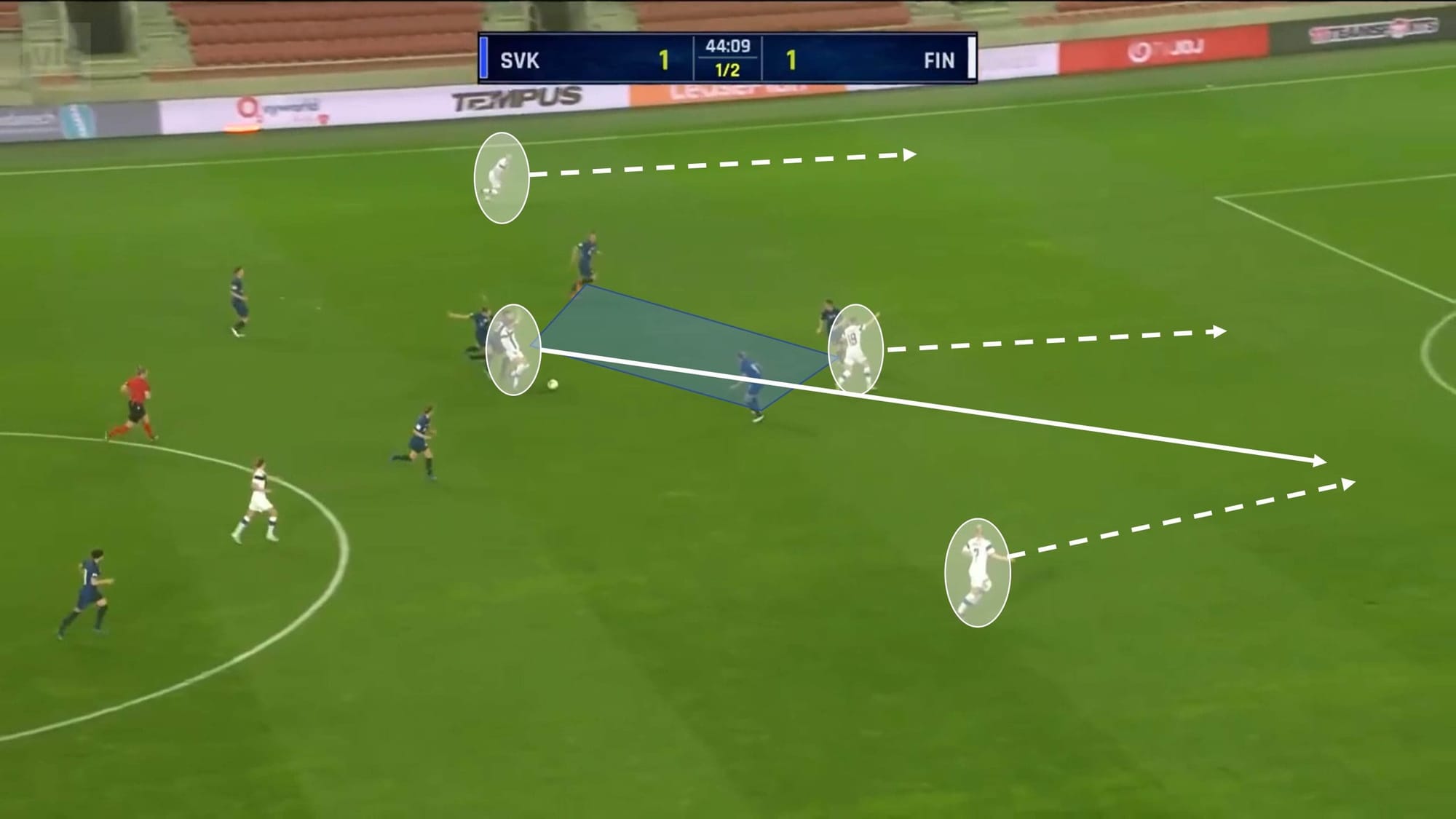
Finland don’t just go down the wing — they will occasionally break through the midfield with their players possessing the ability to take on the opposition. Due to their width, they often enjoy lots of space to create numerically superior attacks in the final third.
Finland create a lot of chances in their matches but are usually lacking in quality to convert a high percentage of these opportunities into goals, with either the final ball or finishing ability coming up short.
Defensive Phase
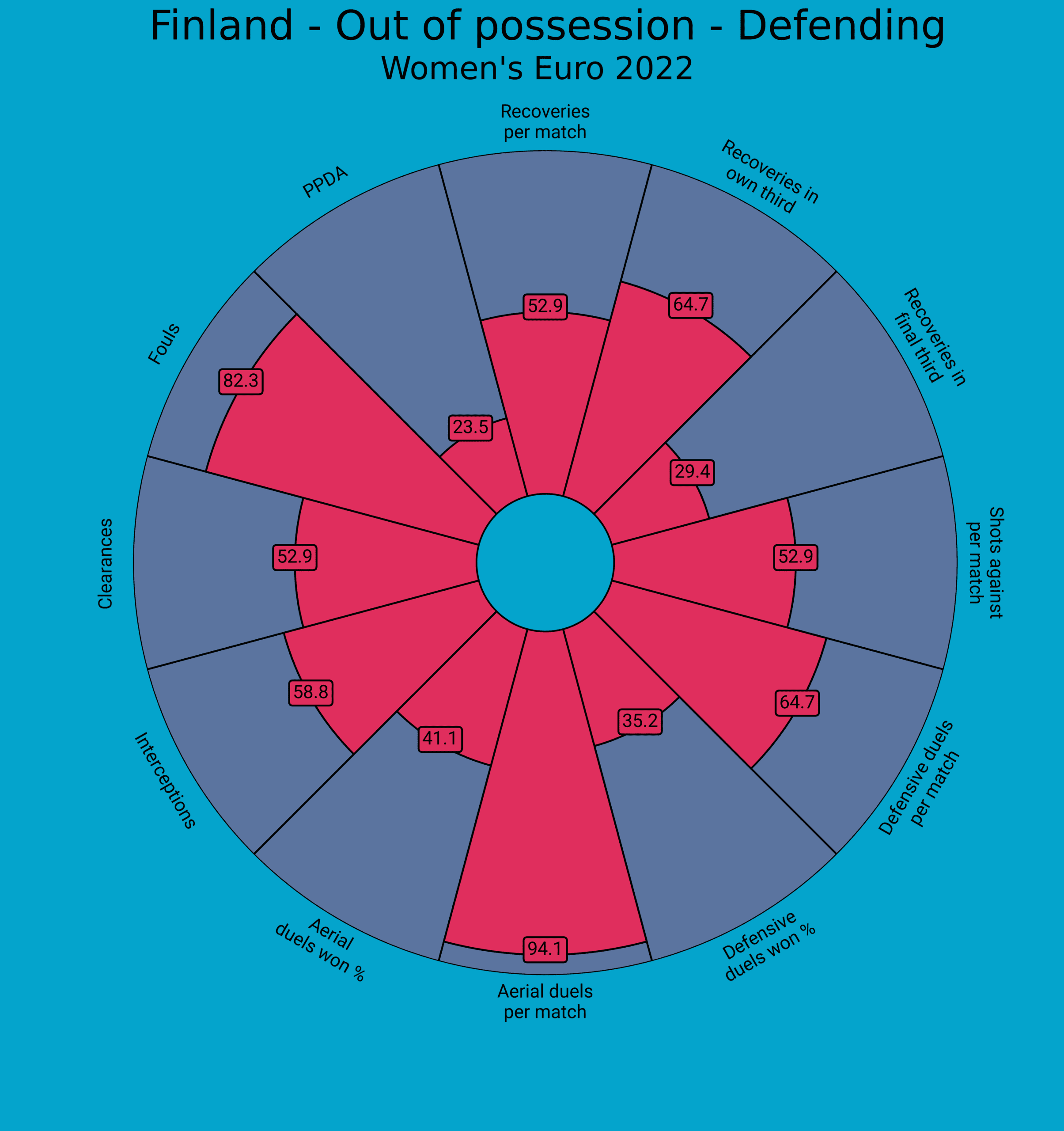
In defence, Finland use quite a demanding playstyle, as they’re accustomed to a high-intensity press. This press is performed all over the pitch, as Finland are not afraid to send lots of players into a condensed space. This press has been highly successful for Finland, with their relatively low PPDA indicating that the opponent often loses the ball to Finland quite early on in their possession play while the Finnish team hunts for the ball aggressively, high up the pitch and close to the opposition’s goal.
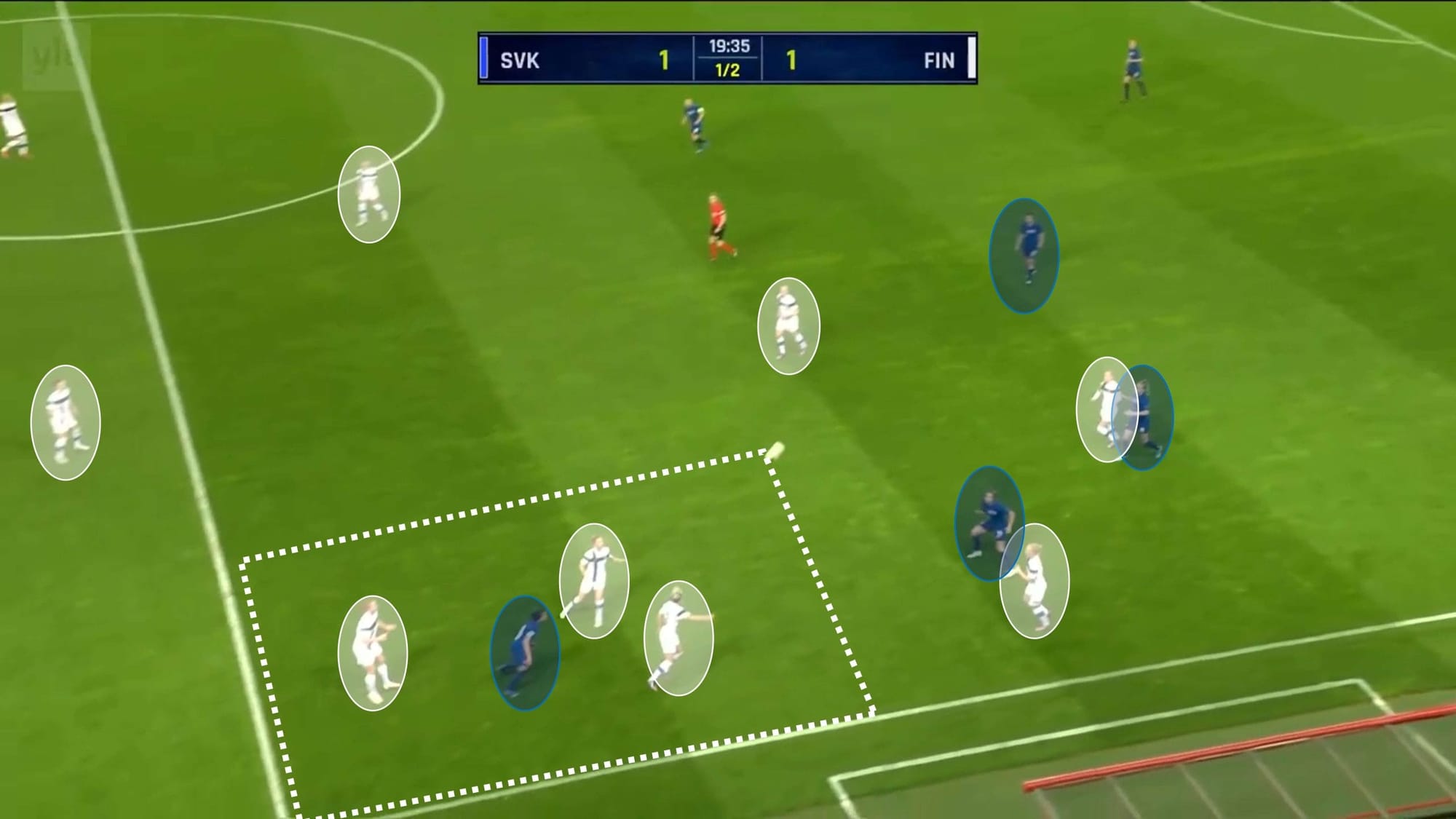
With the high density of players around the ball, their shape becomes very narrow, which can make them effective at winning second balls and forcing the opponents to make mistakes on the ball. Even in their own defensive third, Finland will stick to this high press as they try to cut off any passing options to isolate the player on the ball, thus forcing a one vs one or two vs two.
Finland aim to win the ball as high up the field as they can to quickly create opportunities to score in transition while the opposition is in their attacking structure. No matter where the ball is on the pitch, all of the Finland attackers and midfielders are drawn to the ball making it difficult for the opposition to get a string of passes together.
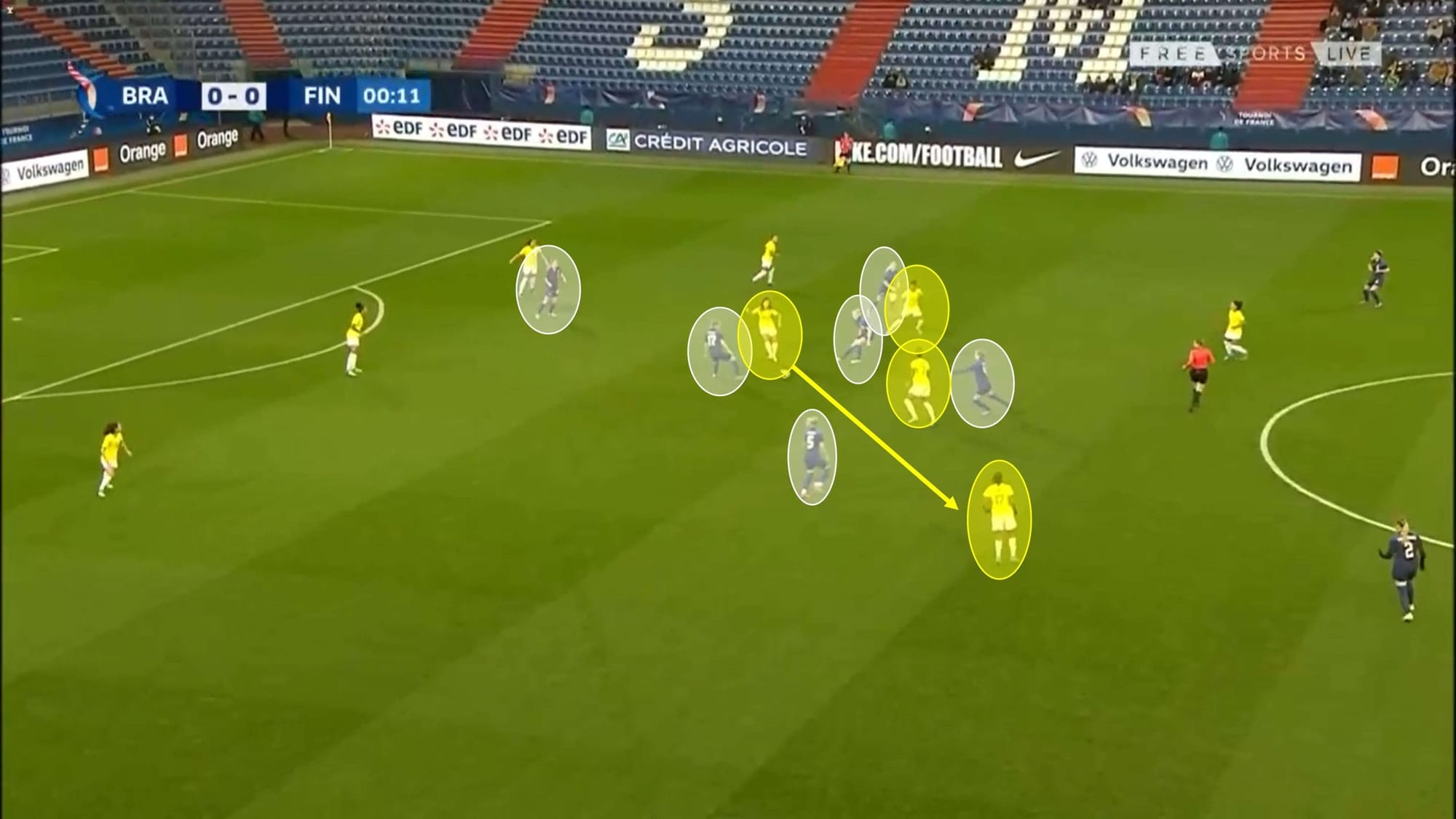
When against stronger opponents, Finland have struggled to use this press effectively, with the opposition often displaying more comfort and composure on the ball, reducing the chance of a mistake and increasing their chances of playing past Finland’s aggressive pressure to free players elsewhere on the pitch. Finland’s defensive shape can become open and disorganised and alongside this disorganised shape, the narrowness of their press provides the opposition with a quick outlet in the wide channels for a simple way to bypass the Finland defence.
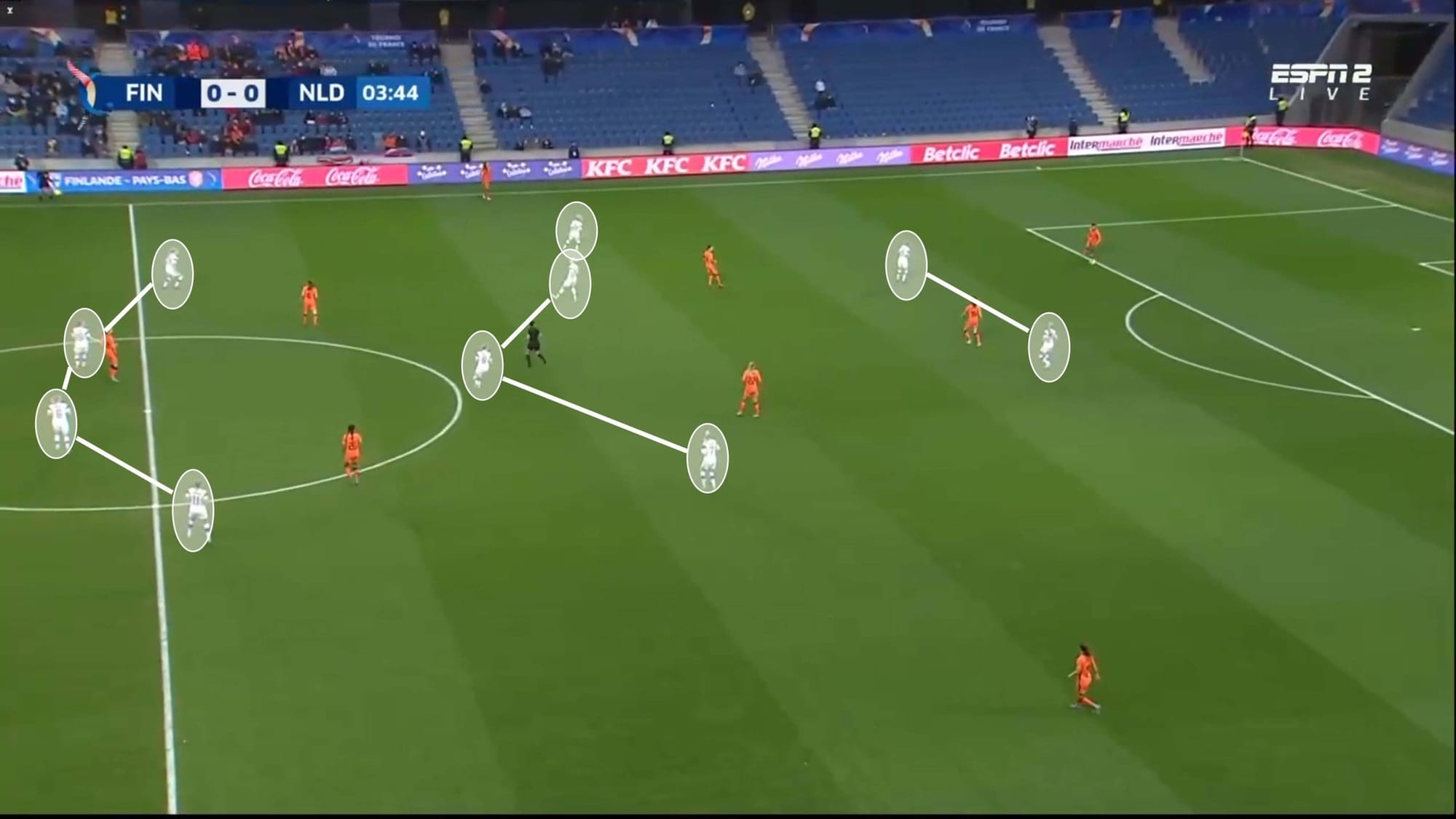
The Finnish shape is usually vertically stretched when they press in the opposition’s half, with their strikers and midfield high and their defence sitting behind the halfway line due to their lack of pace. These spaces between the lines become problematic against teams with creative and skilful players who have good awareness to find a pass through the press.
For the duration of the tournament, Finland will struggle to keep up the intensity of their press, especially against opponents who look to keep possession and drag their shape around, though when they can press with lots of intensity, they are very effective. It will be interesting to see if they choose to stick with this 4-4-2 against all opponents or choose to change their style against different countries, so they can try to stay more defensively compact making it more difficult for the opponent to find an opening.
Transitions
A common theme with the Finnish game plan is numerical superiority and high intensity in every aspect of the game. In the defensive phase, there was a high press with a high density of players getting around the ball. In the attacking phase, it was all about getting players high up the field quickly to catch the opposition out. As with these two demanding phases, the transition between attack and defence is a weakness for this system.
When transitioning from attack to defence, Finland have struggled — especially following a counter-attack of their own. The root of this problem is that Finland tend to get lots of bodies forward, often being numerically superior. However, with so many players committed forward, Finland need to ensure that these chances have an end product and do not break down with a misplaced pass, interception or tackle as this could take a lot of players out of the game.
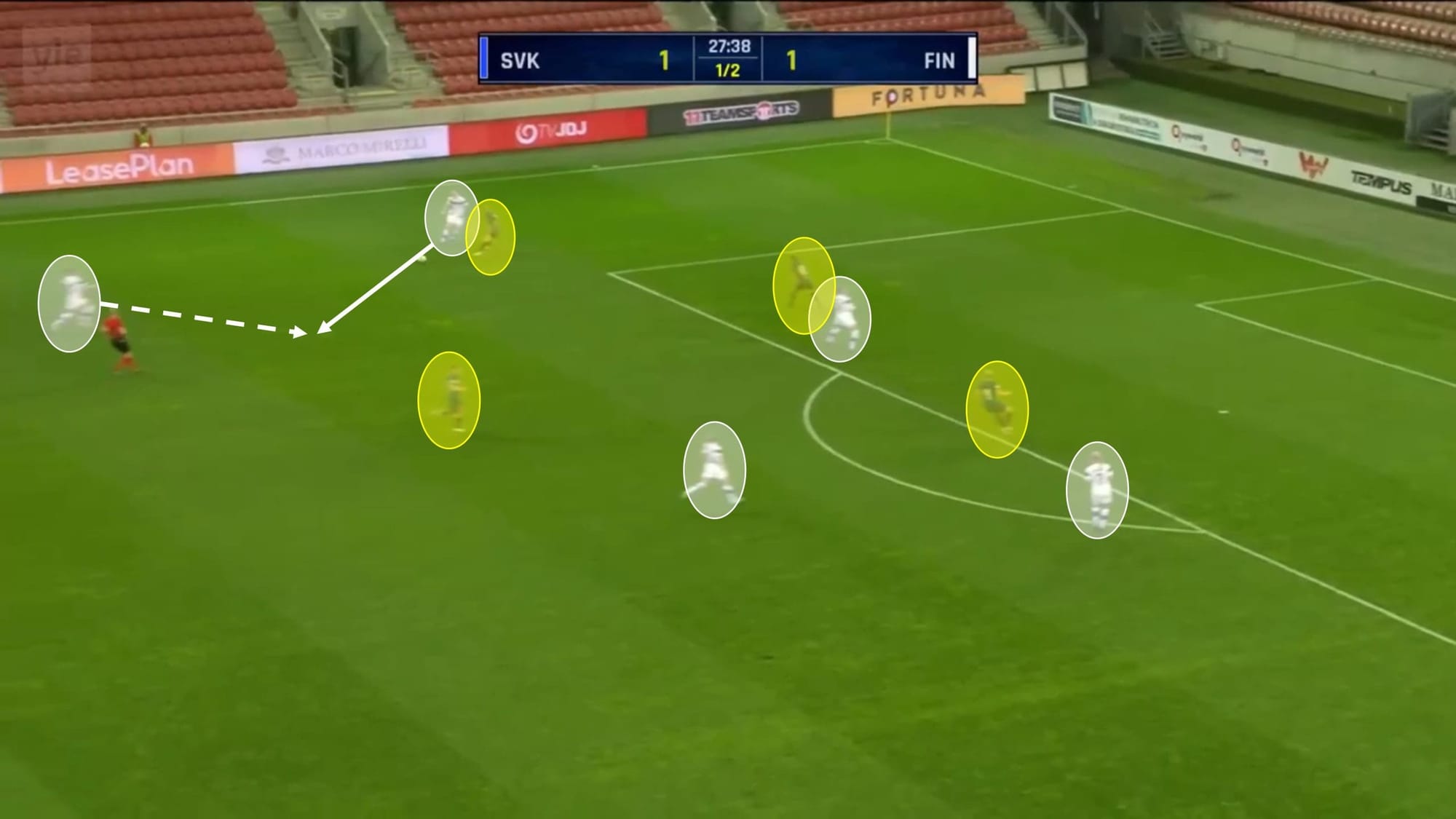
Besides their weakness in transition from attack to defence, they can be lethal in transition from defence to attack, thanks to their utilisation of the high press. This is how loads of Finland’s chances are created, with them being most dangerous in a match when the opposition is chasing back to defend. In these situations, there is lots of open space and the fitness of the players becomes an important aspect, with it being taxing to chase back to defend.
Instantly after Finland win the ball, the focus moves to attacking the space and getting at the opposition defence, even if they are inside their half. With their strikers positioned high up the pitch, Finland always have a quick outlet to get the ball forward to turn the opposition. Once the opposition is chasing back, Finland look to get the ball in the space between the midfield and defence for players to be able to manufacture chances with the space and time from the attack.
Finland can catch out any team thanks to the fitness and speed of their players being above that of most teams at the tournament. With teams that are less comfortable on the ball or make lots of mistakes, Finland will punish them but against teams with the ability to pass, Finland may struggle. Players with the ability to exploit spaces and play pinpoint passes can cut through the transitioning shape of Finland —and many of the teams at the tournament will be able to do this. Also, teams with a compact structure can stop the majority of Finland’s attacks as they are unable to overload a defence to free up players, often lacking the quality of the higher ranking teams at the tournament.
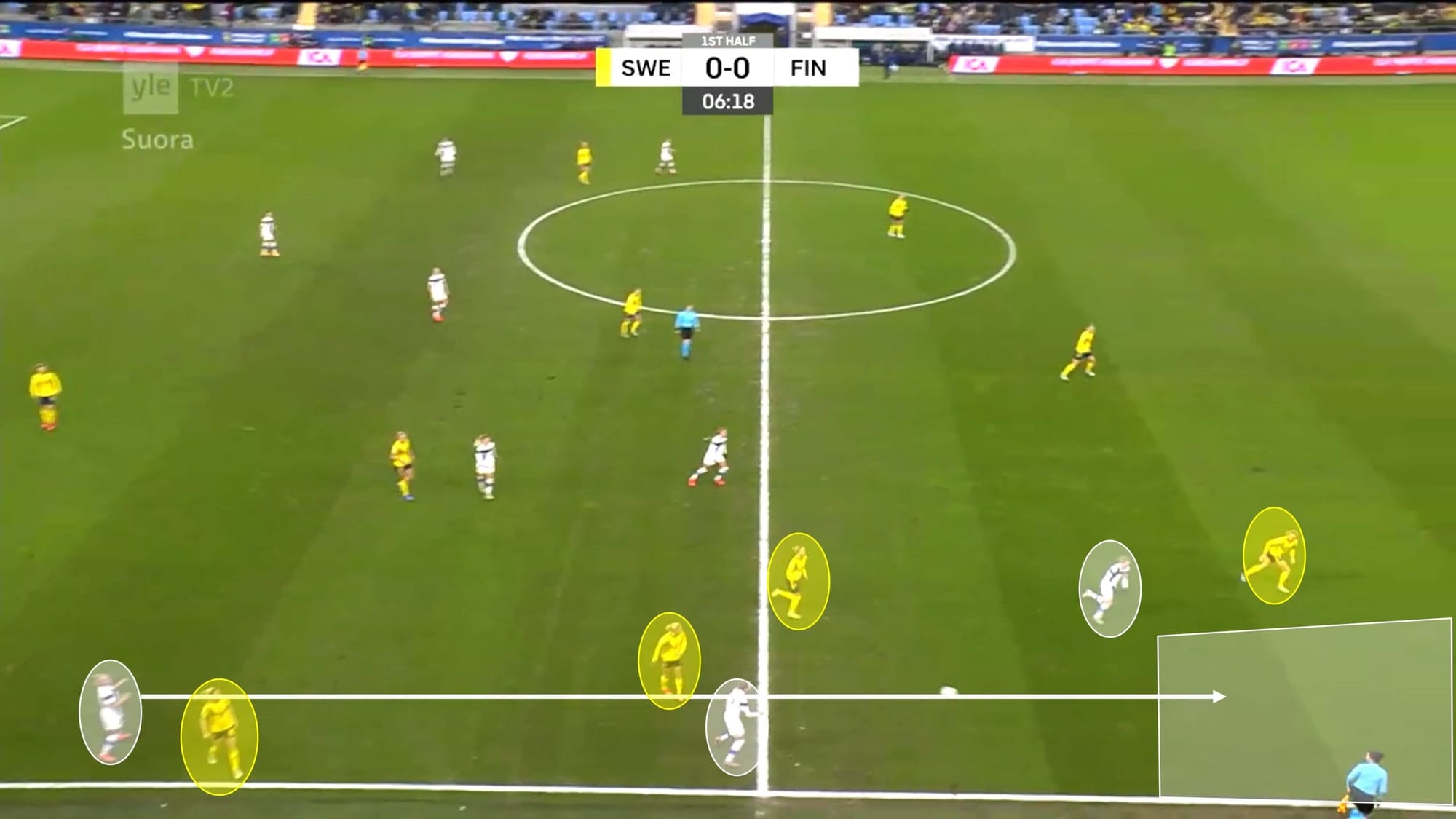
Defenders
When it comes to defenders in the Finland squad, it is clear that the ability to play long balls is very important as this is one of the main passing options for the teams. The centre-backs have high averages for long balls per 90, with Westerlund playing 10.5, Kuikka 8.0 and Auvinen 7.1. With the three centre-backs most likely to start, they must also have enough quality to have the majority of possession go through the centre-backs, as the average number of passes per 90 and their accuracy for Auvinen was 33.5 with 84% accuracy, Kuikka 52 with 83% accuracy and Westerlund 53.5 with 84% accuracy.
Finland’s full-backs are a major outlet with their width for creating opportunities and starting attacks. Making passes down the line into the final third is a quick way to get in behind, as highlighted by Hyyrynen making 6 per 90 and Koivisto 5 per 90. Along with these final third passes, these players are often looked to as being the way forward in the build-up with Hyyrynen playing 17.5 forward passes a match and Koivisto with 13.
Midfielders
The midfielders’ main focus is on winning the ball back with a high press, especially when in the opposition half. Summanen tops the team with recoveries per 90 with 12.1, followed by Sainio with 10.7, Alanen with 8.6 and Engman with 5.6. The average percentage of these in the opposition’s half is 55% for the midfield, making Finland a pressing machine when it comes to winning the ball back in these areas. Anna Signeul’s pressing style is highly important to her game plan and is most effective when she has a team of people looking to press and win the ball back as a group; this is why there is a spread of recoveries between the midfield as all of them have a high number of recoveries.
Chance creation is also important for any midfield as they are required to supply the strikers with shot opportunities. The midfielders are the bridge between attack and defence for the team, especially within the Finland team. They are important to support the strikers with late runs or getting in positions to score. All the midfielders get chances every match with Summanen having 1.3 shots, Sainio 1.1, Engman 1.5 and Alanen 1.13 per 90.
Forwards
In attack, the system demands the strikers to make a lot of forward runs throughout the match, even if they are not getting the ball as this will open up the opposition defence and open space between the midfield and defence. Once on the ball, dribbling is of major importance to keep progressing the ball but also for giving the midfielders time to catch up to the attack. This is where Sällström is lacking in her game and the reason behind her potentially not starting. Sällström averages 2.4 dribbles per match which is behind Öling with 4.4 and Franssi with 5.4 per match.
As a striker, though, it is not all about making runs but also their goalscoring ability. Sällström is undeniably the best goalscorer in the national team as she has the all-time record for goals scored and is the main scoring threat in the team. Sällström averages 0.64 goals per match over 0.5 ahead of Öling with 0.12 and Franssi with 0.1. It will be difficult to choose the starting forwards from these options in the tournament, with Sällström having the goalscoring ability far beyond the other players, but not offering the ability to hound the ball continuously and make as many runs for the team. Bearing this in mind, using her as a substitute or starting her in just one or two of the group stage matches might be the best option.
Best Performer
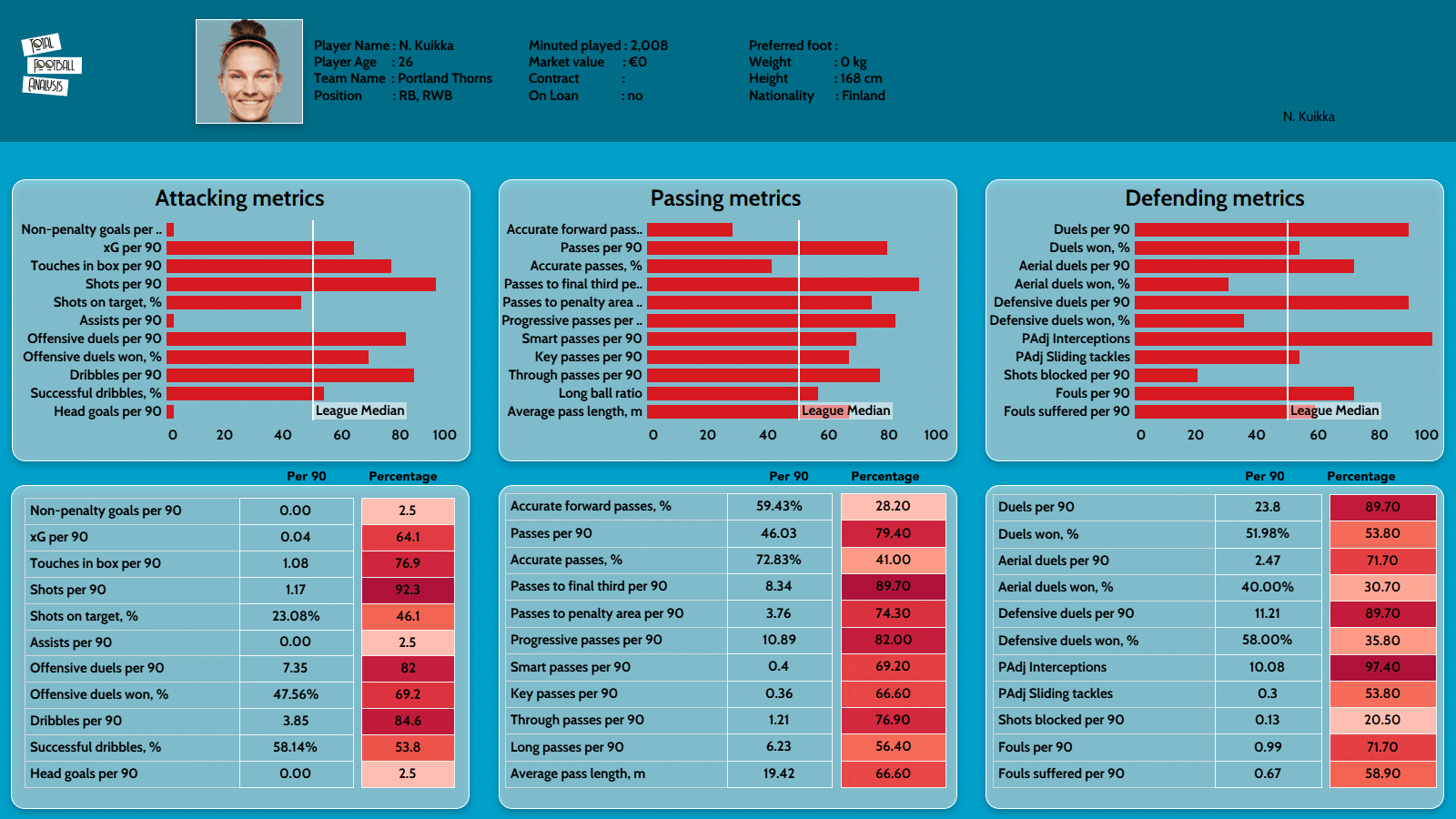
Picking the best player was not difficult when looking at the number of Player of the Year trophies that Kuikka has won, with two consecutive awards for the 2020 and 2021 seasons — and three overall. As the graphic illustrates Kuikka is above average on 75% of the statistics, with the majority being in the passing metrics; this is not surprising considering the centre-backs’ passing threat in the system.
This figure looks at her domestic performances for the last calendar year and compares her statistics in each noted area with the league median for her position. Starting with the defending metrics, Kuikka is a warrior at the back for Finland, winning over 50% of her duels per 90 — almost the most for her league. She is a smart player and knows how to read the game which is highlighted by her almost topping the league in interceptions.
One of Kuikka’s weaknesses is in defending aerial duels, with her only winning about 40%. The aerial ability comes with a lack of height, as she is only 5 foot 5, giving her a disadvantage as a centre-back in the Finland shape. For shots blocked, she is also weak only blocking one every three matches. However, this may be a stylistic thing due to her simply not needing to block many shots during a match.
Passing is her biggest strength when compared to other defenders, with her lowest stat in accuracy in forward passes, which will be due to the style of the team with her long balls often hopeful into spaces of the pitch. With her passing strengths, she is super high for a defender with final third, penalty box and progressive passes as she is in the top 75% of the league. For key passes, she is in the top 70% of the league, which shows her importance in goal creation as well as defending for her sides.
When looking at the attacking metrics, you would suspect that she is a midfielder but it is because of her playstyle. She likes to get on the front foot with an interception and looks to ensure there is an end product to any attacks. Her dribbles per 90 are in the top 85% of the league with a success rate of 58%. For a defender, she averages one shot a game which is very high. She is a staple of the Finland team and gives them the freedom to play the way they do. As Kuikka is only 26, she will take a lot from this tournament no matter the result to use as experience in future major international tournaments.
Tournament Prediction
Finland are a dangerous team with the ability to catch out any team via their high press and intense playstyle, making them a tricky team to play in the group stage. With this playstyle and the frequency of matches at an international tournament, Finland will struggle to maintain this exhausting style.
Finland are in a very tough group with two of the favourites for the Women’s Euro 2022 in Spain and Germany to contend with, making their chance of progression difficult. These two teams can exploit the weaknesses previously spoken about with the high calibre of players in their squads. The other team in their group is also very strong, with Denmark finishing as runners-up at the 2017 Euro tournament and semi-finalists in 2013. As seen in the Tournoi de France, Finland struggled against the higher ranking teams, where they only achieved one point in another difficult group stage, failing to score a single goal and finishing the three matches with a -8 goal difference.
Finland are not expected to progress which may benefit their playstyle, giving them the freedom to work as a team with an underdog mentality. Finland will be hoping to cause an upset in the group stage even if their chances of maintaining their playstyle deep into the tournament will be difficult.

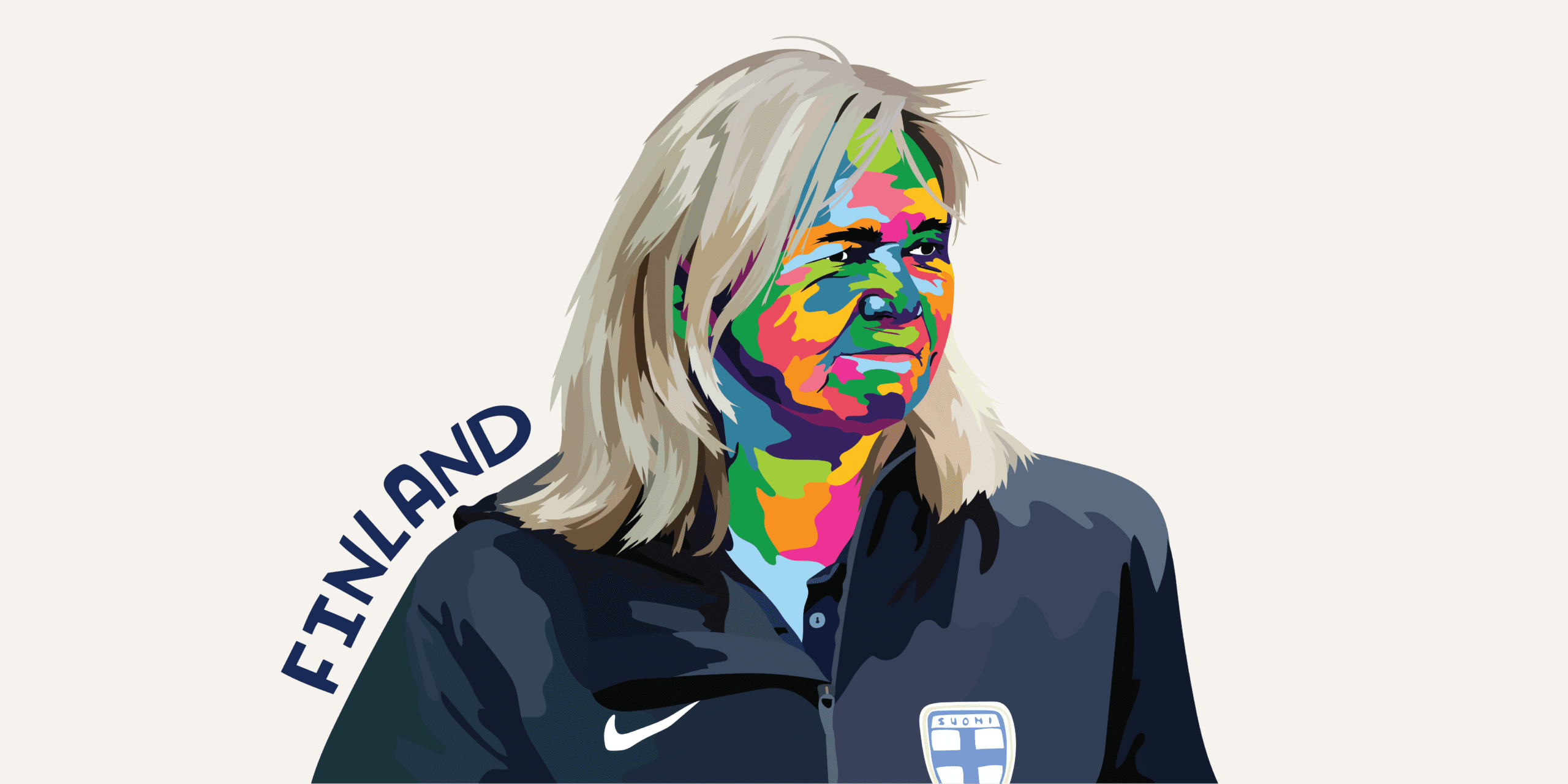




Comments